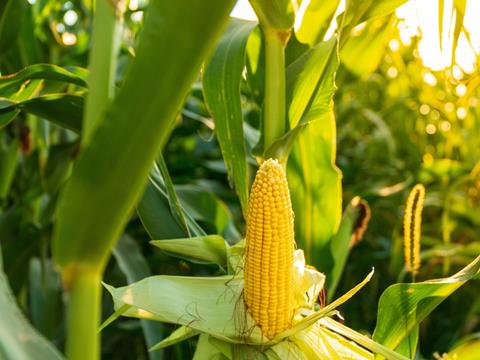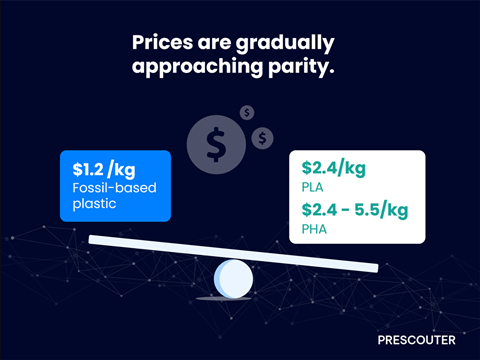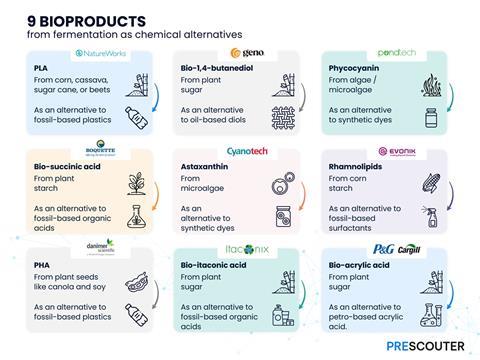
Recent technological advancements in fermentation processes are bringing bioplastics back into the spotlight. According to a new report by PreScouter, fermentation chemicals are showing increased potential to become the next disruptor in the green chemistry revolution.
In this article, Mariam Jomha, PreScouter Marketing Director, examines the report’s key findings and the expanding role & applications of fermentation chemicals in the packaging industry.
As momentum builds, fermentation chemicals are experiencing steady market growth, indicative of a wider trend among manufacturers. One recent example from June of this year is BASF’s research into producing carbon-neutral bio-based fumarate. This precedes their already licensed bio-BDO technology, Genomatica, in 2023.
The term “fermentation chemicals” refers to chemicals produced through a fermentation process of biomass using microorganisms like bacteria, yeasts, fungi, and microalgae. . They are a subset of biobased chemicals.
Battle of the biobased: Fermentation vs plant-based
A biobased material does not automatically equate to being carbon neutral or biodegradable. To accurately assess sustainability, it is essential to consider factors beyond greenhouse gas emissions, including land use changes, biodiversity impacts, and social aspects.
Plant-based solutions are generally seen as more sustainable than fossil-based synthetics, but questions about their carbon neutrality remain. Issues like estimating carbon footprints, measuring emissions, and changes in land use make it difficult to confirm their true environmental impact.
Fermentation chemicals offer a complementary approach with unique advantages:
- Allows for high-potential customization of products and processes.
- Can achieve negative carbon emissions by utilizing biowaste, CO2, or methane as feedstock.
- The processes can be tightly controlled and optimized, ensuring efficiency and consistency.
- Not limited by seasons, does not compete with the food supply, and is not constrained by raw material availability. Depending on the feedstock used, it can also have a lower impact on land and water resources.
- The process can be enantiospecific and tailored for various applications, providing precise and desired outcomes.
PLA and PHA: The front-runners as bioplastic polymers
PLA is produced from renewable plant-based feedstocks such as corn and sugarcane. The organic sources provide carbohydrates that are fermented by bacteria to produce lactic acid, which is then polymerized into PLA. PLA, in turn, is prized for its transparency and strength, making it suitable for various packaging applications.
PHA, on the other hand, is synthesized by microorganisms such as Ralstonia eutropha and Pseudomonas species. The bacteria use organic waste and byproducts as carbon sources, accumulating PHA as an energy reserve under nutrient-limited conditions. PHA’s versatility, including its biodegradability and biocompatibility, makes it an attractive alternative to conventional plastics.
The potential of PLA and PHA to disrupt traditional plastic markets is substantial in the foreseeable future. PLA and PHA material properties can contribute to reducing greenhouse gas emissions and reliance on fossil-fuel-based plastics. For instance, producing PLA from municipal solid waste can lead to a net reduction of 73 kg CO2 per ton. PHA can potentially help reduce fossil energy consumption by 95% and greenhouse gas emissions by 200%.
The market for these bioplastics is on an upward trajectory. The global PLA market, valued at approximately $1.5 billion in 2023, is projected to reach $4.5 billion by 2030, growing at a CAGR of 17%. Similarly, the PHA market, estimated at $93 million in 2023, is expected to grow to $261.9 million by 2030, with a CAGR of 15.9%. This growth is driven by the increasing demand for eco-friendly materials across various industries.
“Fermentation isn’t a new concept, but processes at scale, with price parity with fossil-based synthetic ones and using waste as feedstock have been recently achieved and will continue their double-digit growth trajectory,” notes Dr. Priscila Costa Carvalho, PreScouter Project Architect and report co-author.
PLA’s earlier market entry, lower production costs, and broader application range have enabled it to capture a larger market share. In contrast, PHA’s market, while growing, remains smaller due to higher production costs, scalability challenges, and more specialized applications.
However, ongoing advances in fermentation technology hold the potential to overcome many of the current limitations of PHA. By reducing costs, improving yields, expanding the range of feedstocks, and enhancing material properties, these advances could make PHA a much more competitive and attractive bioplastic for a wide range of applications.
One effort to reduce production costs of PHA is by using more cost-effective feedstocks, such as lignocellulosic biomass and organic waste, which currently account for over 50% of PHA production expenses. Additionally, employing open and mixed culture fermentation can lower operational costs by reducing the need for sterile environments.
One of the observed trends in the PreScouter report is that the prices of bioplastics are gradually approaching parity with fossil-based components. Currently, fossil-based plastics cost around $1.2 per kilogram, while PLA costs $2.4 per kilogram, and PHA costs range from $2.4 to $5.5 per kilogram.

Challenges in production and adoption
Despite their promise, the production of PLA and PHA faces challenges, primarily due to high costs. Fermentation processes are more expensive than traditional chemical production, making it difficult for bioplastics to compete with fossil-based plastics.
“Fermentation chemicals cannot compete with synthetic chemical products if the final cost of the product is too low. Because CapEx and OpEx for the fermentation, for most products, are quite high, the product value must be more than €1000 to €2000 per ton,” according to Jean-Marc Nicaud, PhD, Research Director at INRA French National Institute for Agricultural Research.
The lack of established supply chains for biobased alternatives poses another hurdle. Regulatory issues play a significant role too, especially concerning the use of genetically modified organisms (GMOs) in production.
Regions with stringent GMO regulations may present barriers to market entry for fermentation-derived products. Moreover, large-scale fermentation requires rigorous quality control to prevent contamination, adding another layer of complexity to production.
Leading innovators and future directions
The report profiles 9 bioproducts produced from fermentation that serve as chemical alternatives. More than half of the companies profiled are anticipated to achieve double-digit growth rates, with potential to penetrate billion-dollar markets by 2030.
Of the nine, two prominent examples include:
- NatureWorks, known for its Ingeo PLA
- Danimer Scientific, which produces Nodax PHA

Looking ahead, the scalability of PLA and PHA production will depend on technological advancements and market demand. Innovations in fermentation technologies, such as precision genome editing and advanced metabolic engineering, could further improve the economic viability of these biopolymers. Regulatory support, similar to policies promoting bioethanol, could also accelerate the adoption of biobased products.
From a broader perspective, Dr. Marija Jovic, PreScouter Technical Director emphasizes that “Fermentation chemicals are an attractive strategic option for meeting the growing demand for green chemistry solutions.
They enable the creation of sustainable bio-building blocks that can be used to develop innovative products and solutions across a wide range of applications. Investing in these technological advancements is key to staying ahead of the curve.”
Dr. Jovic’s insight aligns with the broader trend towards sustainable materials, highlighting the critical role of fermentation-generated bioplastics like PLA and PHA. These bioplastics offer a promising avenue for sustainable plastic production, combining environmental benefits with growing market demand. However, while their potential to reduce environmental impact is significant, overcoming production costs and regulatory challenges remains essential for their widespread adoption and success.
If you liked this story, you might also enjoy:
How are the top brands progressing on packaging sustainability?
Sustainable Innovation Report 2024: Current trends and future priorities
Reuse vs. single use – which is better for the environment?
The ultimate guide to global plastic sustainability regulation


















No comments yet